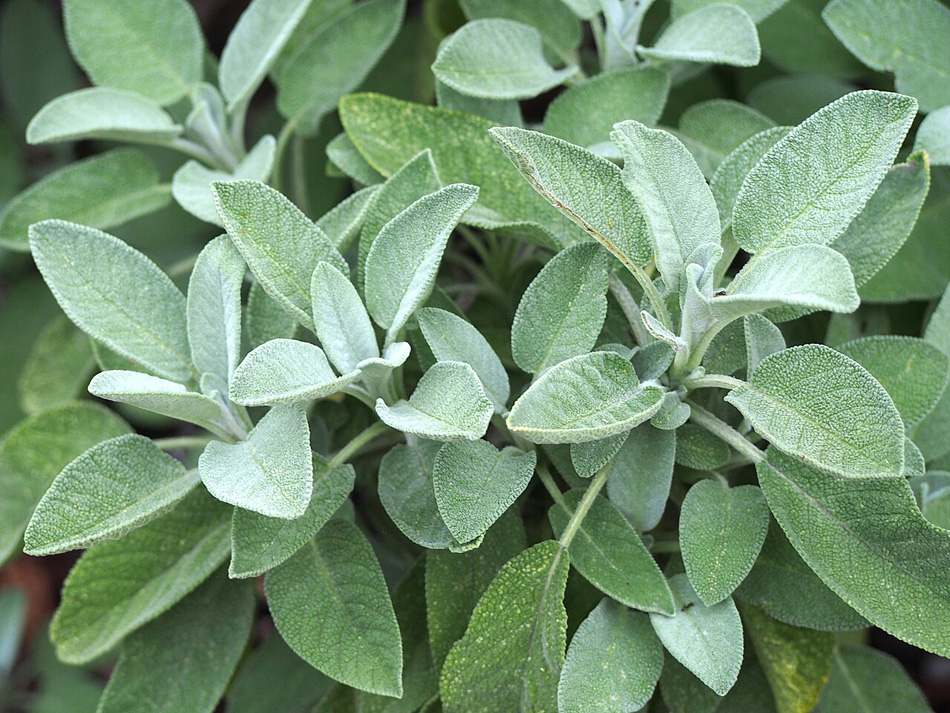Sage - Salivia officinalis
Growing and
Using Herbs
Sage - Herb
Evergreen hardy woody perennial.
Up
to 75cm high, spread 1m+.
Flowers: June - August.
Full
sun or semi-shade.
Grow the species from seed, buy ornamental
cultivars as plants or propagate them from cuttings.
Herbs: Basil | Bay | Chives | Mint | Oregano | Parsley | Rosemary | Thyme | All
The basic muted green leaved form is easily propagated from seed, it is also the strongest grower and most highly flavoured variety. If you want sage purely for culinary purposes this is the one to go for, a handsome plant in its own right and likely to produce blue flowers on spikes in mid to late summer once it is established and large enough.
Sage grows to a dense mound of foliage about 60cm (2 feet) tall and a little more wide. If you're going to use lots go keep it by the vegetable patch, if you're going to use it less frequently, one of the more ornamental cultivars in a border garden will give you enough for cooking and better earn its place, you'll just have to use a little more leaf as they aren't so strongly flavoured.
The cultivars can't be grown from seed but can be bought as potted plants or propagated from cuttings if you know someone who has a plant. Widely available are; purple sage where the new leaves come out purple before fading to green/grey as they age, tricolour a green, white and purple variety and golden sage, also sometimes known as Icterina which has an irregular green center to the leaves which are edged with golden yellow.
I have had a golden sage in the border in my front garden for over ten years now, it gets cut back when it encroaches to far where I don't want it to go. It is large enough to take cuttings of sage leaves and sprigs for cooking right through the winter meaning I don't have to harvest and freeze the leaves in summer for later use.
Sage is perhaps most classically used in sage and onion stuffing which is very easy to make with breadcrumbs and much nicer than anything in a packet from the shop. I use it to flavour gravy along with thyme and a bay leaf, it is also good as an addition to stews. You could chop the leaves up very small and use them this way, though I find it easier to cut a small sprig about 5cm high and wide and add that early on in the cooking, removing it before serving when the flavour has pervaded the dish. If you add it as chopped leaves or as the main flavouring then take care to start with as it can become overpowering.
Lore
Sage is attributed with many healing properties the botanical name Salvia comes from the Latin 'salvere' meaning 'to save". This plant was believed to have extremely powerful magical qualities and most ailments were treated with it at some time such as sore throats, gums, typhoid fever, measles, liver disease, epilepsy etc...you name it. The fresh leaves are reputed to cure warts.
An old English belief is that eating sage every day in May confers immortality.
When burnt and left to smoulder in bunches sage is used for "smudging" to cleanse a space and invite positive energy. A new home for instance should be smudged by taking a smouldering bunch from room to room and then waved in each of the corners of each room, it can also be carried out annually with equal success.
Write a wish on a sage leaf and place it under your pillow for three days before burying it to make the wish come true.
As a strongly flavoured herb, sage was used to mask the smell and taste of rancid meat, the antibacterial properties may have helped too.
Sage seeds and plants to buy

